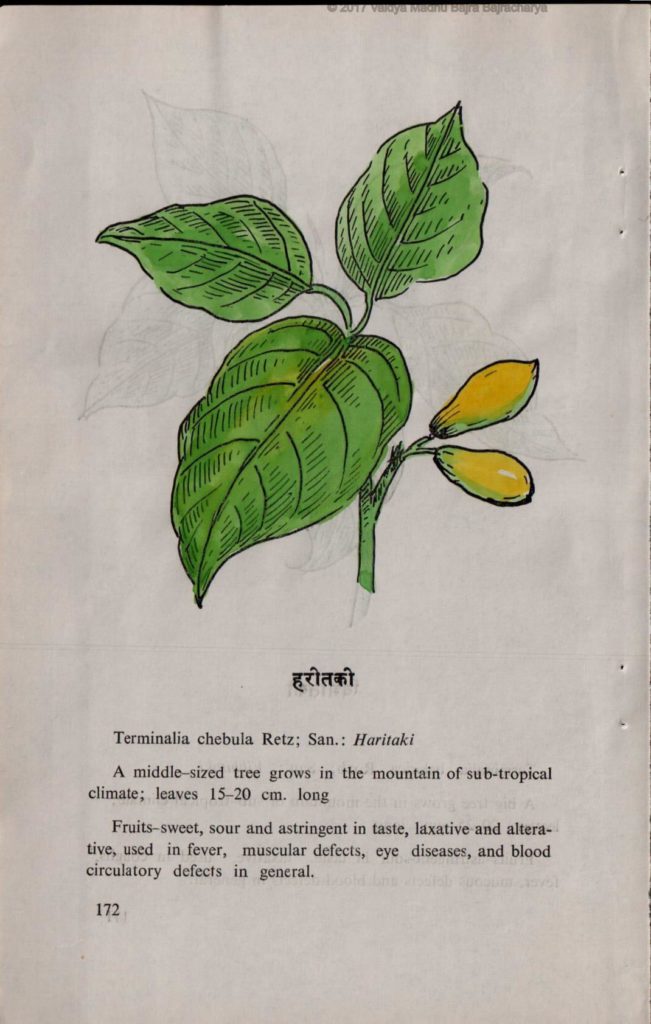Latin: Terminalia chebula
Sanskrit: Haritaki
English: Chebulic myrobalan
Chinese: He zi
WHAT IT DOES: Haritaki fruit is sweet, sour and astringent in taste, as well as slightly bitter and pungent. It is hot in action. It strengthens immunity while exerting a mild laxative effect.
RATING: Gold
SAFETY ISSUES: Not for use by pregnant women due to laxative effect.
STARTING DOSAGE:
• Dried powder: two grams two times per day
• 4:1 concentrated powder extract: one gram two times per day

Haritaki fruit embodies all tastes except salt, one of the many reasons it is designated in TAM as a rasayana tonic, good for health and long life. It is also tridosagna, meaning it can be used with any type of health imbalance. Furthermore, it is an anulomanum—a mild laxative that aids digestion. Haritaki is used to nourish the heart, liver, and kidney, and to treat diseases of the eye, for which it is used both internally and externally.
There are seven types of haritaki fruit:
º Vijaya: looks just a squash and can be used in any case.
º Rohini: is round in shape and more effective for healing.
º Putana: is small in size with big hard seeds, and is useful for external plastering.
º Amrita: is fleshier, and good for body purification.
º Abhaya: has five lobes, and is more effective for ophthalmic use (external).
º Jivanti: is yellow in color and good for all cases.
º Chetaki: has three lobes, is good to use in the form of powder, and is more laxative than the others. Chetaki comes in two varieties—white and black.
The mature (ripe) haritaki fruits are harvested during the autumn season, when they have the strongest medicinal and laxative effect. Drying the fruit properly in the sun to make a powder reduces the laxative effect slightly, and cooking or steaming reduces it even further, due to oxidation of the laxative chemicals. Traditional doctors disapprove of cooking the fruit when it should be sun-dried (a tedious process). The cooking process is thought to weaken the herb’s medicinal effectiveness. However, TCM doctors often cook laxative herbs (such as rhubarb root, which is soaked in wine then fried) in order to remove the laxative properties, so they can be used for other purposes without discomfort to the patient.
Haritaki fruit contains anthraquinone-like (laxative) chemicals as well as tannins and astringents (reported in Kapoor, 1990). To bring out these opposing actions within a given product, Ayurvedic doctors administer it with warm water to strengthen the laxative action, and with ice cold water to promote the astringent action. For example, the juice mixed with cold water can be used as a mouthwash to treat spongy gums.
Thepost-digestive or delayed reaction of haritaki fruit (vipaka) is very strongly nourishing, so this is an excellent choice as a laxative in weak or elderly patients.
Haritaki fruit is part of triphala, the three-fruit formula. It is generally administered in triphala form rather than by itself to draw upon the tonic effects. Each of the triphala fruits is tonic, and together they act to balance the three primary balancing forces, Vata, Pitta and Kapha. At our clinic, following the Ayurvedic tradition, I add triphala to many, many combinations for this balanced tonic action. The wide variety of liver-protective, antioxidant, nutritive and antimicrobial virtues found in these three fruits lends much credence to this traditional practice.
TCM doctors use dried or cooked haritaki fruit to tighten up the stool for chronic diarrhea and dysentery and to “tighten” the lungs in chronic cough. By stating that it can be used for both hot and cold patterns of disease, they are acknowledging the balanced action of this herb.
Research Highlights
• Researchers tested a 10% solution of haritaki fruit extract as a mouth rinse to study its effect on bacteria. The mouthwash significantly inhibited salivary bacterial count and total streptococcal (S. mutans) count for up to three hours compared to placebo, apparently by blocking their ability to utilize sugars (Jagtap and Karkera, 1999).
• Haritaki fruit was one of six Ayurvedic herbs administered to animal to test their adaptogenic potential. All six traditional rasayana plants were able to aid the animals against a variety of different stressors working in different ways (Rege, 1999).
• Alcohol extracts of 82 Indian medicinal plants were tested in vitro against several pathogenic and opportunistic microorganisms. Only five plants had a broad spectrum as well as potent action, one of which was haritaki fruit. The others were amla fruit, vibhitaki fruit, chitrakam (Plumbago zeylanica) and kutaja (Holarrhena antidysenterica). Subsequent animal testing showed no cellular toxicity (Ahmad et al., 1998).
• Tests of alcohol extracts revealed gallic acid and its ethyl ester, two potent antimicrobial substances that acted against even resistant strains of Staphylococcus aureus (Sato et al., 1997). In an AIDS model with immuno-suppressed mice, haritaki fruit was one of four herbs found to significantly reduce viral loads in a chronic lung infection (CMV) commonly found in AIDS patients (Yukawa et al., 1996).
• Haritaki fruit was one of four herbs screened out for potency to test for use with the anti-viral drug acyclovir against herpes (HSV-1) in a study at the Toyama Medical and Pharmaceutical University in Japan. When acyclovir was combined with any one of the herbal extracts and ingested in oral doses similar to human use, the results were significantly stronger than the use of the drug or the herbs alone, especially reducing viral loads in the brains of the animals (Kurokawa et al., 1995).
• Rabbit studies of the cholesterol-lowering actions of each of the triphala fruits showed that haritaki fruit had the strongest effect. Although all three fruits reduced cholesterol, a minor issue, it is significant to note more significantly that haritaki fruit reduced cholesterol deposits in the liver and aorta compared to controls (Thakur et al., 1988).
